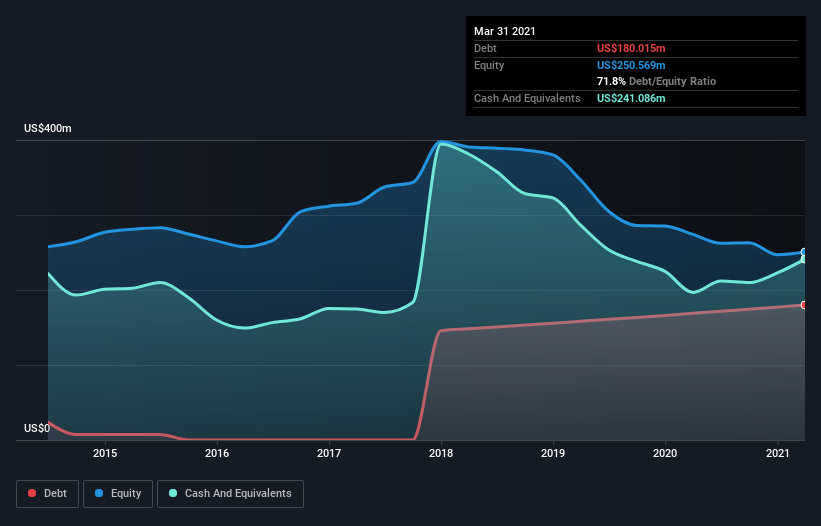David Iben put it well when he said, 'Volatility is not a risk we care about. What we care about is avoiding the permanent loss of capital.' So it might be obvious that you need to consider debt, when you think about how risky any given stock is, because too much debt can sink a company. Importantly, Quotient Technology Inc. (NYSE:QUOT) does carry debt. But is this debt a concern to shareholders?
What Risk Does Debt Bring?
Generally speaking, debt only becomes a real problem when a company can't easily pay it off, either by raising capital or with its own cash flow. If things get really bad, the lenders can take control of the business. However, a more usual (but still expensive) situation is where a company must dilute shareholders at a cheap share price simply to get debt under control. Of course, plenty of companies use debt to fund growth, without any negative consequences. When we examine debt levels, we first consider both cash and debt levels, together.
View our latest analysis for Quotient Technology
What Is Quotient Technology's Net Debt?
The image below, which you can click on for greater detail, shows that at March 2021 Quotient Technology had debt of US$176.4m, up from US$168.9m in one year. However, its balance sheet shows it holds US$241.1m in cash, so it actually has US$64.7m net cash.

How Healthy Is Quotient Technology's Balance Sheet?
We can see from the most recent balance sheet that Quotient Technology had liabilities of US$125.9m falling due within a year, and liabilities of US$201.9m due beyond that. On the other hand, it had cash of US$241.1m and US$119.7m worth of receivables due within a year. So it actually has US$32.9m more liquid assets than total liabilities.
This short term liquidity is a sign that Quotient Technology could probably pay off its debt with ease, as its balance sheet is far from stretched. Succinctly put, Quotient Technology boasts net cash, so it's fair to say it does not have a heavy debt load! There's no doubt that we learn most about debt from the balance sheet. But ultimately the future profitability of the business will decide if Quotient Technology can strengthen its balance sheet over time. So if you're focused on the future you can check out this free report showing analyst profit forecasts.
Over 12 months, Quotient Technology reported revenue of US$462m, which is a gain of 5.9%, although it did not report any earnings before interest and tax. That rate of growth is a bit slow for our taste, but it takes all types to make a world.
So How Risky Is Quotient Technology?
Although Quotient Technology had an earnings before interest and tax (EBIT) loss over the last twelve months, it generated positive free cash flow of US$34m. So although it is loss-making, it doesn't seem to have too much near-term balance sheet risk, keeping in mind the net cash. We'll feel more comfortable with the stock once EBIT is positive, given the lacklustre revenue growth. There's no doubt that we learn most about debt from the balance sheet. But ultimately, every company can contain risks that exist outside of the balance sheet. Case in point: We've spotted 2 warning signs for Quotient Technology you should be aware of.
If, after all that, you're more interested in a fast growing company with a rock-solid balance sheet, then check out our list of net cash growth stocks without delay.
When trading Quotient Technology or any other investment, use the platform considered by many to be the Professional's Gateway to the Worlds Market, Interactive Brokers. You get the lowest-cost* trading on stocks, options, futures, forex, bonds and funds worldwide from a single integrated account. Promoted
Valuation is complex, but we're here to simplify it.
Discover if Quotient Technology might be undervalued or overvalued with our detailed analysis, featuring fair value estimates, potential risks, dividends, insider trades, and its financial condition.
Access Free AnalysisThis article by Simply Wall St is general in nature. It does not constitute a recommendation to buy or sell any stock, and does not take account of your objectives, or your financial situation. We aim to bring you long-term focused analysis driven by fundamental data. Note that our analysis may not factor in the latest price-sensitive company announcements or qualitative material. Simply Wall St has no position in any stocks mentioned.
*Interactive Brokers Rated Lowest Cost Broker by StockBrokers.com Annual Online Review 2020
Have feedback on this article? Concerned about the content? Get in touch with us directly. Alternatively, email editorial-team (at) simplywallst.com.
About NYSE:QUOT
Quotient Technology
Quotient Technology Inc. operates as a digital media and promotions technology company that offers power integrated digital media and promotions programs for brands and retailers.
Flawless balance sheet and overvalued.
Similar Companies
Market Insights
Community Narratives




